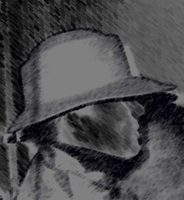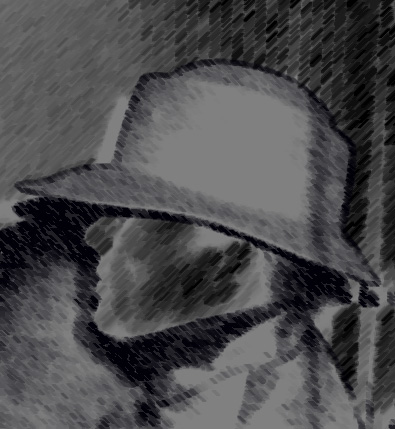










There are liars, damned liars and people who write books about Jack the Ripper
-jack Hamilton
Bookseller
The Mutilated Victims
Martha Tabram
August 7, 1888
George Yard
Whitechapel
Mary Ann Nichols
August 31, 1888
Buck's Row
Whitechapel
Annie Chapman
September 8, 1888
29 Hanbury Street
Spitalfields
Elizabeth Stride
September 30, 1888
40 Berner Street
Whitechapel
Catherine Eddoes
September 30, 1888
Aldgate
London
Mary Jane Kelly
November 9, 1888
Millers Court
Whitechapel
...and perhaps others
Jack the Ripper—The Ashes
Jack the Ripper--The Flesh
The person who gets my vote as the ripper is Canadian-born quack doctor Francis J Tumblety (1833-1903),the youngest of eleven children. He learned about bootleg drugs while working at Dr. Lispenard’s drug store in Rochester, New York. He learned still more as a cleaner at a hospital that did abortions. (Yes--abortions were not only common in mid 19th century, newspapers openly advertised abortifacients with discreet names like “Infallible French Solution.”)
To fill his purse, he peddled porn on Erie Canal boats. Too late he discovered his young wife was a prostitute. That revelation began his “hate affair” with women.
Midcentury he traveled between Detroit and Montreal selling humbug nostrums which were little more than molasses and water. He raked in $300 a day on Tumblety Pimple Destroyer. He pretended to be an Indian herb doctor--and started tangling with the law. In 1857 police arrested him for attempting abortion without a license.
Just before the Civil War, a rich Tumblety returned to Rochester and started a most unusual collection--matrices (uteruses) that he preserved in big glass jars.
In September of 1860 a Nova Scotia court convicted him of manslaughter for poisoning James Portmore with rotgut medicine. He beat prison time by beating it out of St. Johns.
Tumblety was a master of disguise. As the Civil War approached, he stopped painting his face brown in favor of wearing dashing military garb from a bygone era. He grew a mustache and donned high fur shako and earrings. He rode a white horse with his own aristrocratic retinue trailing behind--a handsomely turned out Blackamoor as personal valet leading a pair of matched greyhounds. He was always on the move--Boston, New York, Jersey City, Pittsburgh, San Francisco.
At the outbreak of Civil War, he claimed to be General McClellan’s staff surgeon--glibly lied he was great friends with President Lincoln and Charles Dickens. In Washington D.C. he hosted an infamous all-male dinner party where he called women "cattle" and swore he would rather give a friend poison than see him with a woman. The braggart had no sense of shame. While vilifying women in the daytime, he covered his night-time prowling by telling folks he went to a monastery to pray for his dear departed wife.
When Washington got too hot, he tested the waters in St. Louis and was promptly arrested for wearing military medals he did not deserve. He drew so much attention he was even accused of crimes he did not commit. He picked the wrong alias--Dr. Blackburn. A real doctor of the same name was wanted for plotting to infect Union soldiers with blankets carrying yellow fever. Police even alleged Tumblety conspired with John Wilkes Booth to assassinate Lincoln. To ”Clear his name” he published his ravings in a pamphlet, The Kidnapping of Dr. Tumblety, The first of many self-serving rants he authored.
Jack the Ripper--The Blood
Summer1888 Tumblety took seedy lodgings in London’s East End--not his usual choice of upscale hotel—at 22 Batty Street, a short walk to every murder scene. Whitechapel was a gritty place--a place with 10,000 prostitutes in a population of 100,000. The cost? Four pennies--enough for a shot of gin.
Dr. T aroused suspicion by trying to buy matrices from a pathological museum. He fit the physical description of a person seen near the crime scene—5’11” about 45 years old--wearing a long overcoat. When his landlady gave his blood-soaked shirt to the police, Tumblety shot to the top of their suspect list.
Shortly before the murder of Mary Kelly, police arrested him--on charges of gross indecency (a genteel way of calling him a homosexual pervert.) In late November he skipped bail, sneaked off to France, and sailed to New York City under the alias Frank Townsend.
The Yard sent two dozen men to chase Tumblety across the ocean--not something they would do on a paltry indecency charge. Embarrassed at losing its prime suspect, Scotland Yard apparently covered up--and the British press let them. The world’s attention shifted to New York.
New York City's Chief Inspector Byrnes discovered Tumblety was staying at Mrs. McNamara’s boarding house on East 10th Street. Byrnes could not arrest Tumblety because he had “no proof of his complicity in the Whitechapel murders, and the crime for which he had skipped bail was not extraditable.”
New Yorkers cringed and cowered under the knowledge the Ripper might strike any one any time. Ripper tension rose--then evaporated. On the 5th of December, Tumblety vanished for five years. In 1893, he turned up in Rochester to live with his sister and his collection of uteruses. From his home base, he dashed about to his favorite cities--Baltimore, New Orleans and St. Louis.
Some years later all information and the arrest warrant on Francis Tumblety went missing from Scotland Yard. Today New Scotland Yard has no original files on the murders, no evidence, nothing.
Francis Tumblety died in St. Louis on May 28th, 1903 at age 70 and was sent to Rochester for burial. His personal belongings included a collection of preserved uteruses in glass jars, some expensive jewelry and two cheap brass rings--rings like Annie Chapman wore before her throat was cut in the backyard of 29 Hanbury Street.
The Ripper file was officially closed in 1892--just four years after the most sensational crime of the century.
Where did he go after 1888? Tumblety blamed women for all the trouble in the world. Perhaps he continued his crusade against the fair sex on other continents.
London newspapers suggested he kept busy in Jamaica and Nicaragua. In January 1889, dark Managua alleys witnessed the slashing of 6 low women in less than 10 days.
He flitted from hotel to hotel and from city to city. In April 1903 he checked himself into St. John's Hospital and Dispensary at 23rd and Locust Streets in St. Louis. Even in his last days, he wouldn’t compromise his principles by telling the truth. He swore he was a pauper.
Tumblety died May 28, 1903. However, he was not penniless. He left a $135,000 estate to his niece in Rochester. His funeral cost $37.60 in St. Louis and $68.50 in Rochester.
Want to know more?
Cornwell, Patricia. Portrait of a Killer: Jack the Ripper, Case Closed. G.P. Putnams’ Sons. NY. c2002
Evans, Stewart P. and Paul Gainey. Jack the Ripper: First Ameircan Serial Killer. Kodansha International, NY. 1996.
Ryder, Stephen P. (Ed.). Casebook: Jack the Ripper.
Police News. Gillian Wagner "Barnardo" Weidenfield and Nicholson 1979
www.met.police.uk/history/
